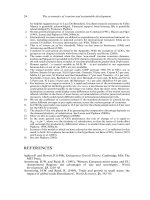THE ECONOMICS OF MONEY,BANKING, AND FINANCIAL MARKETS 377
Bạn đang xem bản rút gọn của tài liệu. Xem và tải ngay bản đầy đủ của tài liệu tại đây (58.37 KB, 1 trang )
CHAPTER 13
Banking and the Management of Financial Institutions
6. If the First bank decides to convert $5 million of its
fixed-rate assets into rate-sensitive assets, what will
happen to its interest-rate risk? Explain using gap
analysis.
7. What happens to the market value of the bank s
assets if the interest rate increases by 2 percentage
points?
8. What happens to the market value of the bank s liabilities if the interest rate falls by 2 percentage
points?
9. What will happen to the bank s net worth if interest
rates rise by 10 percentage points? Will the bank
stay in business? Why or why not?
10. WestBank just started operations with $6 million in
capital. On the first day of operations, it received
345
$100 million in chequable deposits and issued
$25 million non-mortgage loans and another $25
million in mortgages.
a. If the desired reserve ratio is 8%, what does the
bank s balance sheet look like?
b. On the second day of operations, the bank
decides to invest $45 million in 30-day T-bills,
traded at $4986.70 per $5000 face value. How
many T-bills does the bank purchase? How does
the bank s balance sheet look after the purchase
of these T-bills?
c. On the third day of operations, deposits fall by
$5 million. What does the balance sheet look
like? Are there any problems? If yes, how can
the bank address the problems?
WEB EXERCISES
1. It is relatively easy to find up-to-date information on
banks because of their extensive reporting requirements. Go to www.osfi-bsif.gc.ca. This site is sponsored by the Office of the Superintendent of Financial
Institutions Canada (OSFI). You will find balance sheet
data on domestic banks as well as on foreign bank
subsidiaries.
a. Have bank loans been increasing or decreasing
over the last few years?
b. Has bank capital been increasing? How does it compare to the figure reported in Table 13-1 (p. 315)?
2. Table 13-1 reports the balance sheet of all commercial
banks based on aggregate data found in the OSFI s
website. Compare this table to the balance sheet information reported (under Financial Highlights) by CIBC
at www.cibc.com /ca/inside-cibc/fin-higlights.
html. Does CIBC have more or less of its portfolio in
loans than the average Canadian bank?
3. This chapter discussed the need financial institutions
have to control credit risk by lending to creditworthy
borrowers. If you allow your credit to deteriorate, you
may find yourself unable to borrow when you need to.
Go to www.quicken.com/cms/viewers/article/
banking/39654 and assess your own creditworthiness. What can you do to improve your appeal to
lenders?
4. The CDIC is extremely concerned with risk management in banks. High-risk banks are more likely to fail
and cost the CDIC money. The CDIC regularly
examines banks and rates them using a system
called CAMELS. Go to www.fdic.gov/regulations/
safety/manual/index.html. What does the acronym
CAMELS stand for? Go to Part II. 7.1 and review the discussion of Market Risk. Summarize the interest-rate
risk-measurement methods.
Be sure to visit the MyEconLab website at www.myeconlab.com.This online
homework and tutorial system puts you in control of your own learning with
study and practice tools directly correlated to this chapter content.
On the MyEconLab website you will find the following appendices and mini-cases for this chapter:
Appendix 13.1: Measuring Bank Performance
Appendix 13.2: Nonbanking Financial Institutions and Duration Analysis
Mini-Case 13.1: Bank Performance Analysis
Mini-Case 13.2: Calculating and Comparing Gap, Duration, and Risk Management Alternatives









